KONISHIKI
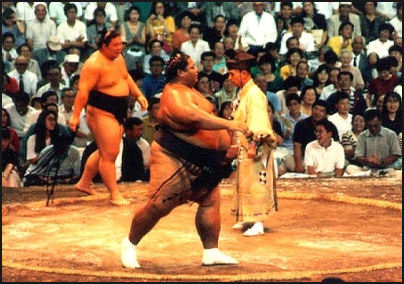
Konishiki Konishiki, an American named Salevaa Atisonoe, was the largest Sumo wrestler in history, weighing as much a 650 pounds (296 kilograms). Born in Hawaii to Samoan parents, he gave up a football scholarship in the United States to take up sumo in Japan in 1982. He wrestled for 16 years, acquired Japanese citizenship in 1994 and retired in 1998.
Konishiki (which means "small brocade") achieved the rank of ozeki. In 1992, he seemed like a shoo in for the rank of yokozuna after winning the prestigious Emperor's Cup for the third time. But he was denied the honor because the old fogies on the promotion committee said he lacked hinaku ("dignity") and he reached his peak at time when relations between Japan and the United States were strained because of a trade war. Konishiki’s grotesque size didn’t help either; some in the media called him the “Meat Bomb,” the "Dump Truck," and “Black Ship.”
Konishiki and his fans thought he was discriminated against. "If I were Japanese, I'd be a grand champion now," he told the press. Later he said he was misquoted. His yokozuna promotion almost became a diplomatic issue. The showdown never came because Konishki failed to pick up his second consecutive win, the criteria required to be named a yokozuna.
Konishiki racked up 733 wins and 498 losses in his career. He was known for his explosive thrusting style but his critics claimed he was simply an oversized freak who used his massive bulk to win matches. He was so large — and still is — that he needed to buy two seats when he flew on commercial airlines. Women found him attractive though. For a while he was married to Japanese model Sumika Shioda.
Websites and Resources

Musashimaru's handprint Links in this Website: SPORTS IN JAPAN (Click Sports, Recreation, Pets ) Factsanddetails.com/Japan ; SUMO RULES AND BASICS Factsanddetails.com/Japan ; SUMO HISTORY Factsanddetails.com/Japan ; SUMO SCANDALS Factsanddetails.com/Japan ; SUMO WRESTLERS AND SUMO LIFESTYLE Factsanddetails.com/Japan ; FAMOUS SUMO WRESTLERS Factsanddetails.com/Japan ; FAMOUS AMERICAN AND FOREIGN SUMO WRESTLERS Factsanddetails.com/Japan ; MONGOLIAN SUMO WRESTLERS Factsanddetails.com/Japan
Good Websites and Sources: Nihon Sumo Kyokai (Japan Sumo Association) official site sumo.or ; Sumo Fan Magazine sumofanmag.com ; Sumo Reference sumodb.sumogames.com ; Sumo Talk sumotalk.com ; Sumo Forum sumoforum.net ; Sumo Information Archives banzuke.com ; Masamirike’s Sumo Site accesscom.com/~abe/sumo ; Sumo FAQs scgroup.com/sumo ; Sumo Page http://cyranos.ch/sumo-e.htm ; Szumo. Hu, a Hungarian English language sumo site szumo.hu ; Books : “The Big Book of Sumo” by Mina Hall; “Takamiyama: The World of Sumo” by Takamiyama (Kodansha, 1973); “Sumo” by Andy Adams and Clyde Newton (Hamlyn, 1989); “Sumo Wrestling” by Bill Gutman (Capstone, 1995).
Sumo Photos, Images and Pictures Good Photos at Japan-Photo Archive japan-photo.de ; Interesting Collection of Old and Recent Photos of Wrestlers in Competition and in Everyday Life sumoforum.net ; Sumo Ukiyo-e banzuke.com/art ; Sumo Ukiyo-e Images (Japanese-language Site) sumo-nishikie.jp ; Info Sumo, a French-Language site with Good Fairly Recent Photos info-sumo.net ; Generic Stock Photos and Images fotosearch.com/photos-images/sumo ; Fan View Pictures nicolas.delerue.org ; Images from a Promotion Event karatethejapaneseway.com ; Sumo Practice phototravels.net/japan ; Wrestlers Goofing Around gol.com/users/pbw/sumo ; Traveler Pictures from a Tokyo Tournament viator.com/tours/Tokyo/Tokyo-Sumo ;
Sumo Wrestlers : Goo Sumo Page /sumo.goo.ne.jp/eng/ozumo_meikan ;Wikipedia List of Mongolian Sumo Wrestlers Wikipedia ; Wikipedia article on Asashoryu Wikipedia ; Wikipedia List of American Sumo Wrestlers Wikipedia ; Site on British sumo sumo.org.uk ; A Site About American sumo wrestlers sumoeastandwest.com
In Japan, Tickets for Events, a Sumo Museum and Sumo Shop in Tokyo Nihon Sumo Kyokai, 1-3-28 Yokozuna, Sumida-ku, Tokyo 130, Japan (81-3-2623, fax: 81-3-2623-5300) . Sumo ticketssumo.or tickets; Sumo Museum site sumo.or.jp ; JNTO article JNTO . Ryogoku Takahashi Company (4-31-15 Ryogoku, Sumida-ku, Tokyo) is a small shop that specializes is sumo wrestling souvenirs. Located near the Kokugikan national sports arena, it sells bed-and bath accessories, cushion covers, chopstick holders, key chains, golf balls, pajamas, kitchen aprons, woodblock prints, and small plastic banks — all featuring sumo wrestling scenes or likenesses of famous wrestlers.
Konishiki, Entertainer and Pitchman
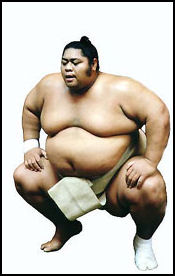
After his retirement, Konoshiki became a major celebrity and Japan's most beloved pitchman. He hosted one television show, appeared regularly on others, endorsed numerous products, and even recorded an album of reggae, R&B and hip hop songs called Konishiki KMS (KMS stands for Konishiski Master Sumo)
One rap from his album entitles Livin' Like Kings goes like this: “Built to last like the Energizer Bunny Pushing '700 and still makin' money Step in my Dojo, you're bound to get crowed, Thrown out the line or smashed to the ground. Competition? I'm the biggest, ain't no rookie. Overweight lover and still known to boogie. Bring the house down when I hit the floor, And sing karaoke for an encore.”
He tried to keep the right to the name Konishiki but Japan Sumo Association said he couldn't use it. Eventually they said that he could use the name if was written in English not Japanese.
In 2000 and 2001, Konishiki made more money from commercials than any other active or retired athlete in Japan. He plugged coffee, vacations in Hawaii, United Airlines, Suntory whiskey, a long-distance telephone service, a convenience store chain, and others. In the ads he dressed in a pink bunny suit, shook his booty doing hip hop dances and sat in a tree with a puppet parrot, playing a ukelele.
Konishiki has also made commercials for the Education Ministry, encouraging kids to study, and set up a foundation to help needy Hawaiian children. He regularly appears at fundraisers for other charities and shows up on kids television shows.
Konishiki reached a peak weight of 303 kilograms. By 2009 he was down to 178 kilograms thanks to gastric bypass surgery and a strict diet.
Takamiyama
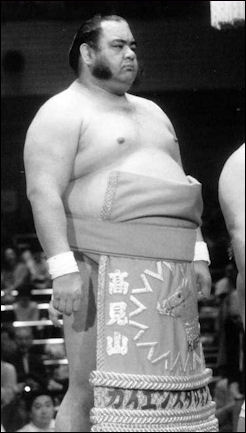
Takamiyama The first non-Asian to find success in sumo was Takamiyama, a massive Hawaiian named Jesse Kuhaula who entered the sport in the 1960s. He won a tournament, made it to the high rank of sekiwake, but never became an ozeki or yokozuna. His greatest achievement perhaps was his longevity. He competed in 122 tournaments and had 812 wins (and 845 losses) over 20 years, retiring in 1984, less than a month shy of his 40th birthday. Takamiyama set records for top division tournaments (97), top-division bouts (1430) and most consecutive top-division bouts (1231). He now talks with a weak, strained voice, the result of years of having hands shoved into his throat.
There were other foreigners who came before Takamiyama but he was the first “obvious one” whose foreign identity was not hidden In a nod to the impact Takamiyama had on sumo, retired yokozuna Mushashimaru said, “The guys who come before me...they had to break the rules. The first guy came, the second guy...we smoothed out the road, made it wide for everybody...That’s how we are here, that is why the Mongolians and Europeans came.”
Takamiyama was recruited in Maui in Hawaii and became a sumo wrestler in 1964 at the age of 19 and competed in a bright orange belt. . He told the Daily Yomiuri, “I didn’t know nothing about sumo, when he arrived in Japan and said the first year was the toughest.
In July 1972, Takamiyama became the first foreign-born sumo wrestler to win the Emperor's Cup. The victory was marked during the award ceremony with the reading of a congratulatory letter from U.S. President Richard Nixon, the first time English was spoken at a sumo tournament.
Takamiyama never made it to ozeki in part because of prejudice towards him as foreigner. He received hate mail and death threats as he was rising through the ranks in the 1960s. He told the Daily Yomiuri, “It was only 20 years after World War II. “The Japanese didn’t want to lose to a foreigner, because they lost the war.” But despite this he was also well liked by te Japanese public and appeared in a number of television commercials, plugging everything them futons to some of Japan’s first home-produced personal computers.
Takamiyama became a Japanese citizen in 1980, partly so he could open his own stable. After he retired he opened a stable under the name Azumazeki. Akebono was his protégé. Azumazeki retired from sumo in 2009 after 45 years in the sport. After he retired Azumazeki was hailed by the U.S. Congress for his “achievements to sumo and his contribution ro enhancing United States-Japan relations.”
Akebono

Akebono Akebono is the second heaviest (230 kilograms, 516 pounds) and tallest (204 centimeters) wrestler in sumo. The first non-Japanese to attain the rank of yokozuna, he is a former basketball player from Hawaiian named Chad Rowan.
Akebono earned over a $1 million a year in salary and prize money. In April 1996, he became a naturalized Japanese citizen under the name Taro Akebono so that he could open his own stable when he retired. He was one of the main figures in the opening ceremony of the 1998 Olympics in Nagano.
Akebono watched sumo on television when he was growing up. Hawaii was one of the few places outside of Japan that sumo was broadcast. He was "discovered" in Honolulu by a local sumo enthusiast in 1987 and joined the Tokyo stable of Azumazeki (the wrestler Takamiyama) in 1988 while still a teenager. After entering competition he scored a majority of wins in a 18 consecutive tournaments (March 1988 to March 1991).
Overcoming knee injuries, drunken rowdiness, prejudice, injuries and language and cultural barriers, Akebono became the best sumo wrestler in Japan in the early 1990s. He was named an ozeki after just 27 tournaments and was named the 64th yokozuna in 1993 at the age of 23 after only 30 tournaments.
Akebono won two bashos in 1993 and one each in 1994 and 1995. He a number of famous battles with Takanohana and Wakanohana. One his more embarrassing defeats came when he was pushed out of the ring by Minomi, one of sumo’s smallest wrestlers. .
Book: “Gaijin Yokozuna, a Biography of Chad Rowan” by Mark Panek (University of Hawaii)
Akebono's Success
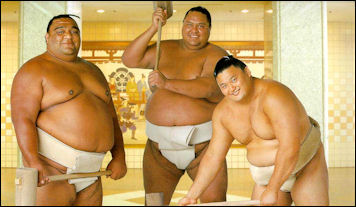
Akebono, Takanohana and Musashimaru Akebono's success was partly the result of good timing. Three dominant wrestlers retired about the same time that Akebono was reaching his peak, and the Japan Sumo Association had to promote someone to grand champion. When Akebono achieved the rank of yokozuna it was the top story in every Japanese newspaper and television news report.
Learning from Konishiki's mistake, Akebono's remained stoic and respectful even when it seemed he was treated unfairly. "You take things as you find them," he told Reid, "and I've found you have to kiss some butt to get ahead in this business."
In 1994, Akebono announced he was considering marrying Noriko Usui, a 23-year-old former model. The 1993 romance, which was referred to as the Joe DiMaggio-Marilyn Monroe relationship of Japan, later fell apart when Usui broke down in tears on national television and reported that Akebono was messing around with another woman. After the announcement, Akebono got drunk and trashed an Osaka bar.
In 1998, Akebono tied the knot with Christine Kalina, a Japanese-American woman who had already bore him a daughter. The wedding was televised nationally in Japan. Over 1,000 guests came, including many celebrities. His wife's kimonos cost a quarter million dollars.
Akebono and Takanohana
In the bashos that Akebono and Takanohana fought in together, Akebono tended to lose one or two matches to low-ranking wrestlers in the early going and faced off against Takanohana on the final day of the match for tournament championship, with Takanohana usually winning.
On Takanohana and Wakanohana, Akebono once said, "I feel that without those two brother, I wouldn't have been what I am today. Everyday when I first joined they were on the front pages of the sports papers. So I felt if I wanted to be on the front page I had to beat these two guys. I used to hang their pictures up where I slept and just stare at them every day."
Although, Takanohona won almost twice as many bashos as Akebono, the two wrestlers were 21 and 21 in head to head matches.
Akebono's Later Career

Young Akebono Akebono didn't win any bashos in 1996, won one in 1997, didn't win any in 1998 and 1999 when he didn't look very sharp and missed several tournaments due to back and knee injuries, which many blamed on the fact that his long legs couldn't hold the weight he carried. He came very close to quitting in 1999.
In November 2000, at the age of 31, Akebono won his 11th basho in Kyushu, defeating Takanohana and Musashimaru in the final two bouts to finish with a 11-2 record. The win placed him seventh on the list of all-time tournament champions. Akebono had the best record of any wrestler in 2000, with 76 wins. He won his 10th basho in July with a 13-2 record. He also racked 13-2 victories in May and September but didn't win.
Akebono announced his retirement in January 2001, bring to an end his 13 year career. The formal retirement ceremony took place in September. U.S. Ambassador Howard Baker and Takanohana were among 320 patrons and supporters to take a snip of his hair before his top knot was completely removed by his stablemaster Azumazeki. After retiring he worked at Azumazeki’s stable, played golf and tried to lose weight by talking long walks.
Akebono then returned to Hawaii where he said he spent 2½ years doing little, in the processing shedding 27 kilograms to reach a weight of 203 kilograms. Then he decided to take up a second career as a K-1 kick boxer, a move which many sumo afficionados regarded as disgraceful. Akebono lost miserably in six out of seven of his K-1 fights. Once he got knocked out and landed in very embarrassing belly-flop- fashion on the mat. Time described Akebono’s move to K-1 as the equivalent of Mikhail Baryshnikov joining a WWF SmackDown.
Akebono fought former NFL player Bob Sapp in a K-1 bout on New Years Eve 2003. Bob Sapp won. Akebono was knocked down in the first round. Akebono said he made the decision to fight K-1 because his future in sumo was limited, he couldn’t raise the money needed to start his own stable and K-1 offered him good money. In 2006, Akebono could be seen on late night television on professional wrestling tag team.
Musashimaru

Takanohana and Musashimaru Musashimaru's was the second non-Japanese to become a yokozuna. Born Fiamalu Penitani in Samoa in 1971, he was raised in Waianae, Hawaii, and now in a Japanese national. He is six-foot-three (191 centimeters) and weighed 525 pounds (237 kilograms) when he fought as a member of the Musashigawa stable, also the home of other top wrestlers such as Musoyama and Miyabiyama.
Musashimaru was born in American Samoa. He moved to Hawaii when he was 10. Later he told the Japan Times, "I was recruited when I was 18. I guess I got my started in sumo thanks to the American football and Greco-Roman wrestling I was doing at school in Hawaii. When they talked to me I knew it was a once-in-a-lifetime thing. All I thought was I have nothing to lose."
Musashimaru entered sumo in 1989 and quickly moved up the ranks. He made it to juryo in 1991 and was promoted to ozeki in 1994. H advanced with a relentless pushing and thrusting attack and solid right-hand grip technique. He took Japanese citizenship in 1996.
In May 1999, at the age of 28, Musashimaru became the 67th person to be named a yokozuna. He had just won two Emperor's cups in a row, driving out Akebono in the final match in a Tokyo basho a few days before.
Musashimaru won 12 titles, a record for a foreign-born wrestler at the time and 6th on the all-time list. He also holds the record for straight Kachioshi (winning record): 55. He only had one losing record in his career. Musashimaru retired in 2003. He had struggled for two years with a wrist injury and had missed a number of bashos. He said, “I couldn’t maintain the responsibility that a grand champion has. That was the main reason I retired.”
Kootooshu and Baruto

Baruto on the left Kotooshu from Bulgaria is the first European sumo wrestler to reach the rank of ozeki and first Francean wrestler to win a championship. He is handsome, very tall (202 centimeters), weighs 155 kilograms and turned 25 in 2008. He has talent and good technique but often gets nervous and makes mental mistakes that allow lesser opponents to beat him. He won his first tournament in May 2008 with a 14-1 records, winning 12 straight and defeating two yokozunas. His father was in the stands waving a Bulgarian flag when he sealed victory on the final day of the basho.
Great things were expected of Kotoosha, whose real name is Kaloyan Stefanov Mahlyanov. He earned the fastest ever promotion to ozeki in 2005 at the age of 22 with three runner-up performances after only 19 tournaments. But a series of knee injuries affected his mobility after his promotion and has been in danger of losing his ozeki rank several rimes after posting losing records. One time he dropped out of a tournament after a 2-7 star. His won-loss percentage in 2007 was only .566 one of the worst ever for an ozeki.
In March 2010, blonde-haired Estonian wrestler Baruto was promoted to ozeki after going 14-1 in the Osaka basho. Even though he only lost once he failed to win the tournament because Hakuho had a perfect 15-0 record. In the basho before that, in Tokyo , he went 12-3. A former judako who once worked as a nightclub bouncer, Baruto arrived in Japan in 2004 and worked his way up to the second-tier juryo division in the autumn of 2005. He became the first wrestler in 43 years to win the juryo title with a perfect 15-0 records in the 2006 spring basho and joined the elite makuuchi division two months later.
Baruto is big and strong and likes to lift up his opponents by their belts and deposit them out of the ring. Injuries though affected his career and twice he was demoted to juryo. Baruto is the second European and eighth foreign-born wrestler to be promoted to ozeki. His real name is Kaido Hoovelson.
The name "Baruto" is a bastardization of "Baltic." Standing 1.96 meters tall and weighing 177 kilograms, he is one of the tallest and largest wrestlers. He was born in 1984 and won an Estonia national title in judo before coming to Japan to take up sumo. Baruto sometimes has flashes of brilliance but has been nagged by chronic knee problems.
Baruto Wins 2012 New Year Basho
In January 2012, Ozeki Baruto clinched his first career title with a victory over rival Kotoshogiku, achieving the feat with two days to spare at the New Year Grand Sumo Tournament. Dave Hueston of Kyodo wrote: Baruto's 13th consecutive win coupled by a third loss by deflated and vanquished yokozuna Hakuho, secured the title for the Estonian goliath at a meet that had all but lost steam in the title race a day earlier at Ryogoku Kokugikan. Baruto got both hands on the back of Kotoshogiku's (7-6) mawashi after a short exchange of slaps before dumping his opponent to improve to an insurmountable 13-0. He became the ninth foreign-born wrestler and second from Europe after Bulgarian Kotooshu to win a championship. [Source: Dave Hueston. Kyodo, January 21, 2012]
"I don't have that much to say but I am excited," said Baruto, who made his debut at sumo's No. 2 rank at the 2010 summer meet. "The championship had been a dream of mine until now. I have made a strong effort at this meet and there was a lot of pressure in the title race. I tried not to focus on the title and just give my all."
Hakuho, who had the wind knocked from his sails after a second defeat the previous day against ozeki Harumafuji, also looked out of sorts against Kotooshu in the day's final bout. Ozeki Kotooshu (10-3), who had not beaten the yokozuna since the 2009 summer basho, got his hand in for a tight grip on Hakuho before heaving him over the straw bales in dominant fashion. "I wanted to make a strong charge but I hesitated a little at the tachiai. I wanted to cut him loose from the grip on my mawashi, but I couldn't stop him. I have to reflect on this defeat," said Hakuho, whose 22nd victory would have placed him in a tie for fifth on the all-time list with former yokozuna Takanohana.
Sumo’s First-Ever African (and Arab) Wrestler
Sumo’s first Arab wrestler, Egyptian Abdelrahman Ahmed Shaalan, who goes by the fighting name Sunaarashi (sandstorm), joined the Otake stable in Tokyo in September 2011.At 15, Shaalan, who had already developed a massive physique through bodybuilding, first tried his hand at sumo in a friend's club in Egypt.Throwing himself into the sport, he improved rapidly and within months had won a bronze medal representing Egypt at the 2008 Junior World Sumo Championships in Estonia. [Source: John Gunning, Yomiuri Shimbun, September 2011]
In April 2012, AFP reported: “With legs resembling tree trunks and packing the body weight of two average-sized men, sumo wrestling's "Great Sandstorm" would seem a good fit for the wildly popular Japanese sport But Egypt's Abdelrahman Ahmed Shaalan, the first professional sumo wrestler from both the African continent and Arab world, faces some mighty challenges as he embarks on a quest to become a yokozuna, or grand champion. [Source: AFP, April 9, 2012]
The man known by the ring name Osunaarashi, which translates as Great Sandstorm, prays five times a day as a devout Muslim, a tough routine given the intense daily training schedule required for sumo's highly ritualised contests. Shaalan is among the sport's first Muslim competitors. As such, the 20-year-old does not touch the deep-fried pork cutlets loved by millions of Japanese or drink vast quantities of beer and rice wine sake, staples of a diet that sumo wrestlers rely on to bulk up. Muslims avoid pork and alcohol.
But Shaalan, who stands at 189 centimetres (6 ft 2 ins) and weighs 145 kilograms (320 pounds), quit his university accounting degree to enter sumo's professional ranks, is undeterred, even brushing aside the challenges presented by the holy month of Ramadan when he cannot eat or drink during daylight hours. Regular sumo tournaments are held in the afternoon. "I am confident that I can overcome my challenges," the burly wrestler told Japanese media last month after winning his first two professional-level matches at a tournament in the western city of Osaka.
Shaalan, a native of Giza, which is home to Egypt's pyramids, insisted he was able to train for at least four hours in the daytime during the Islamic celebration. Japan's sumo association could not say whether the Great Sandstorm is the sport's first Muslim competitor. There have been unconfirmed reports of Muslim sumo wrestlers in the past. His coach, a former wrestler known as Otake, has promised he'll keep his new recruit in top shape, even changing the recipe for a meat, vegetable and fish stew known as Chankonabe which wrestlers devour on a daily basis. "When we serve pork cutlet, we prepare chicken cutlet for him. When we use pork for Chankonabe, we let him eat something else," the coach said. "But I want him to get used to the customs and traditions of the sumo world otherwise."
Shaalan’s love affair with sumo began at the age of 15 when he was invited by a friend to a practice session. "I was impressed by the strength of sumo wrestlers who behaved as if nothing had happened even after they lost or got tired," he said. "I want the world to understand sumo." Shaalan's arrival in the pro ranks came after he won an open-class bronze medal at the 2008 world junior sumo championships and an over-100 kilogram bronze at the 2010 edition.
Other Foreign Sumo Wrestlers
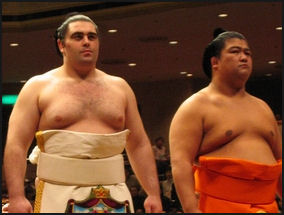
Goki from the country of Georgia In 2008, there was a record 21 foreign-born wrestlers in the top division at the New Year basho. In 2007, for the first time, the number of foreign wrestlers exceeded Japanese wrestler in the top four ranks of yokozuna, ozeki, sekiwake and komosubi.
Top- ranked foreign wrestlers have included Kokkai and Tochinoshima from Georgia; Baruto from Estonia; Kasugao from South Korean as well as wrestlers from Mongolia and Bulgaria. Kobkai won the juryo division in the fall of 2003 and was boosted up to the top division. He finally called it quits in 2012 after 12 years in the sport. He set a record for continual appearances on the dohyo at 882. The highlight of his career was a 2005 victory over former yokozuna Asashoryu.
There were three Russian wrestlers, including two brothers, competing in early 2008 but they got kicked out of sumo for marijuana use (See Scandals). Roho, one of the brothers, was ugly and had a bad boy image. In June 2007, he got into a stare down contest with Chiyotaikai. After the bout he punched a newspaper photographer, for which he received a three-day suspension. In another basho he shoved a wrestler hard after a match was over and grumbled loudly after he felt he lost a match because of referee’s decision against him. For many Japanese his lack of manners was inexcusable.

Kootuoashu on the right The first European to compete in sumo was an 18-year-old Englishman Nathan Strange (Hidenokuni), who debuted in 1989 and left the sport after eight months, In 1992, stable masters agreed to allow 20 stables to have up to two foreign wrestlers. The number of foreign wrestlers increased from 46 in May 2002 to 51 in 2003 to 61 out of 700 ranked wrestlers in February 2005
Other foreign wrestlers over the years have included Hoshi-tango, a hairy Argentine and Takanoyama, a blond-haired Czech and wrestlers from Tonga, China and Brazil. Many of those who entered the sport have said they did so to get money.
Brazilian wrestler Kaseu made his debut in May 2011 and won his first nine matches. Tochinoshin from Georgia did well in 2010. In 2011 Takanoyama became the first Czech wrestler to make it to the makuuchi division.
Foreigners have proven vital to keeping sumo alive as more Japanese youngsters choose baseball, football and other lucrative or more high-profile sports with less rigid conventions. However fans sometimes seem to resent the presence of foreigners, and condemn them vicously when they show un-Japaneseness. Look at what Asashoryu endured.
Fat accumulates differently on the European sumo wrestlers than its does on the Japanese .
Image Sources: Sumo Forum. Sumo Info.et, Japan Zone, Nicolas Delerue, Japan-Photo.de
Text Sources: New York Times, Washington Post, Los Angeles Times, Daily Yomiuri, Times of London, Japan National Tourist Organization (JNTO), National Geographic, The New Yorker, Time, Newsweek, Reuters, AP, Lonely Planet Guides, Compton’s Encyclopedia and various books and other publications.
Last updated January 2013
